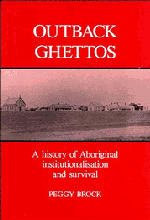Description
Outback ghettos a history of aboriginal institutionalisation and survival
Aborigines, Institutionalisation and Survival
Studies in Australian History Series
Language: English
Publication date: 09-1993
190 p. · 18x25.6 cm · Hardback
Out of Print
190 p. · 18x25.6 cm · Hardback
Out of Print
Description
/li>Contents
/li>
Up until the 1970s, a large proportion of Aboriginal people in Australia had some experience in institutions as part of government assimilation and protection policies. By focusing on three communities in South Australia, this book attempts to understand the consequences of this institutionalisation for Aborigines and Australian society in general. Peggy Brock uses the word 'ghetto' to evoke the nature of the missions in which, for generations, many Aboriginal people settled, as ghettos both oppress and nurture those who live within them. Within the missions, Aborigines were able to establish strong communities and construct a modern identity. The three communities considered in the book - Poonindie, Koonibba and Nepabunna - existed during distinct but overlapping periods and had varying responses to colonialism and mission life. In many cases, Aboriginal people associated themselves with the missions because they met urgent needs for survival: protection from a hostile world, access to rations, education and training in European skills. In fact for many, the missions became home. For others however, the emotional turmoil caused by the pressure to embrace Christianity on the one hand and the desire to maintain traditional ways on the other became unbearable.
1. Introduction, 2. Legislation and policy: the context of outback ghettos, 3. Poonindie, home away from country', 4. An established community and its destruction, 5. Koonibba, a refuge for west coast people, 6. Institutional upheaval and adjustment, 7. Dispersal and the end of the mission era, 8. Adnyamathanha: survival without institutionalisation, 9. Nepabunna mission, 10. The ghetto experience and survival, Bibliography, Index.
© 2024 LAVOISIER S.A.S.
These books may interest you

Rights for Aborigines 160.25 €



